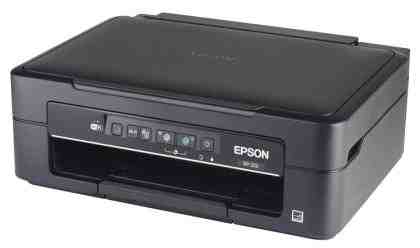Recent additions to Epson's Expression Home range of inkjet all-in-one printers have been cheap and cheerful by nature, but the Epson Expression Home XP-212 really works hard to keep your buying costs low. It's not much to look at, but under the surface it has a lot to offer.
As well as its awkwardly recessed USB port, the MFP has built-in Wi-Fi and supports Epson's iPrint apps for Android and iOS, making it easy to print whatever you need from popular mobile devices as well as desktop computers. The lack of a screen on an MFP with standalone printing and copying features does throw up a few limitations, though.

With just one mono and one colour copy button, making multiple photocopies is a lot trickier than with MFPs that have a screen. The XP-212 has a tiny rear paper tray, too, capable of holding just 50 sheets of standard A4 printer paper, but we were pleased to find that it uses four individual ink cartridges, rather than a tri-colour cartridge system of the kind often used in budget printers and MFPs.
While the cyan, magenta and yellow cartridges use dye-based ink for optimal photo printing performance, the black ink cartridge is filled with pigment-based ink, designed to produce sharp text that doesn't bleed. Even if you buy high yield ink cartridges, print costs are rather high at 11.5p per page of mixed black and colour, while a mono page is a somewhat more reasonable 3p.

When it comes to the MFP's core features, it's fairly well specified, if slightly slow. Epson uses the realistic ipm (images per minute) standard in its quoted speeds and lists the all-in-one as having a mono print speed of 6.2ipm and a colour speed of 3.1ipm. Using our test documents, we saw speeds of 6ppm for a mono print job and a sluggish 1.6ppm for an admittedly challenging set of heavily illustrated colour documents.
Epson Expression Home XP-212 Print Quality
It might be slow, but the XP-212 is rather good and handling brightly coloured illustrations and charts. Some dark areas showed marks left by the print head, but in generally we were pleased by its sharp, vivid reproduction of our graphical document. Unfortunately, its reproduction of text in the same document, particularly at small sizes, left something to be desired. 8pt serif text was legible, which is the critical point, but lettering was visibly jagged. Fortunately, this improves when it comes to larger point sizes and sans serif text.
The 12pt text of our mono letter looks as we'd expect from a budget inkjet. There are some flaws visible upon close examination, but nothing that makes it any way jarring or uncomfortable to read. You'll want to avoid draft mode, though. It is admittedly very fast at 14.9ppm, but we can think of few situations in which most people would want to put up with the very pale with several white lines running through each letter.
